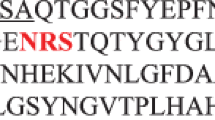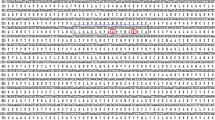Abstract
The isolation, heterologous expression, and characterization of a new, thermostable β-glucanase from Paenibacillus jamilae are described. The bgl26 gene from the P. jamilae Bg1 VKPM B-13 093 strain, which consists of 714 nucleotides, encodes endo-1,3-1,4-β-glucanase (EC 3.2.1.73), which contains 213 amino acids and 24 residues of the putative signal peptide in the N-terminal region. The nucleotide sequence of the bgl26 gene and the amino acid sequence of the mature Bgl26 protein have the greatest homology with the sequences of the Paenibacillus macerans endo-1,3-1,4-β-glucanase (82 and 88%, respectively). A gene fragment encoding the mature protein was expressed in Pichia pastoris. The purified recombinant enzyme Bgl26 was active against barley β-glucan. The optimal pH for the enzyme activity was 7.0, and the optimum temperature range was 40–45°C. The specific β-glucanase activity was at the level of 6650 U/mg of protein; KM and Vmax were equal to 6.4 ± 0.3 mg/mL and 9450.1 ± 471.2 μmol/(min mg), respectively. The recombinant protein Bgl26 was characterized by a high pH and thermal stability, as well as resistance to digestive enzymes. It was also shown that Co2+ ions have a positive effect on enzyme activity.




Similar content being viewed by others
REFERENCES
McCarthy, T., Hanniffy, O., Savage, A.V., and Tuohy, M.G., Catalytic properties and mode of action of three endo-β-glucanases from Talaromyces emersonii on soluble β-1,4-and β-1,3; 1,4-linked glucans, Int. J. Biol. Macromol., 2003, vol. 33, no. 1 (3), pp. 141–148. https://doi.org/10.1016/S0141-8130(03)00080-1
Ekinci, M.S., McCrae, S.I., and Flint, H.J., Isolation and overexpression of a gene encoding an extracellular beta-(1,3-1,4)-glucanase from Streptococcus bovis JB1, Appl. Environ. Microbiol. 1997, vol. 63, no. 10, pp. 3752–3756.
Teng, D., Wang, J.H., Fan, Y., et al., Cloning of β-1, 3-1, 4-glucanase gene from Bacillus licheniformis EGW039 (CGMCC 0635) and its expression in Escherichia coli BL21 (DE3), Appl. Microbiol. Biotechnol., 2006, vol. 72, no. 4, pp. 705–712. https://doi.org/10.1007/s00253-006-0329-2
Huang, H., Yang, P., Luo, H., et al., High-level expression of a truncated 1,3-1,4-β-D-glucanase from Fibrobacter succinogenes in Pichia pastoris by optimization of codons and fermentation, Appl. Microbiol. Biotechnol., 2008, vol. 78, no. 1, pp. 95–103. https://doi.org/10.1007/s00253-007-1290-4
Martinez, M.J., Reyes, F., Lahoz, R., and Perez-Leblic, M.I., Lytic enzymes in autolysis of Botrytis cinerea,FEMS Microbiol. Lett., 1983, vol. 19, nos. 2–3, pp. 157–160. https://doi.org/10.1111/j.1574-6968.1983.tb00532.x
Bang, M.L., Villadsen, I., and Sandal, T., Cloning and characterization of an endo-β-1,3 (4)glucanase and an aspartic protease from Phaffia rhodozyma CBS 6938, Appl. Microbiol. Biotechnol., 1999, vol. 51, no. 2, pp. 215–222.
Boyce, A. and Walsh, G., Production, purification and application-relevant characterisation of an endo-1,3 (4)-β-glucanase from Rhizomucor miehei,Appl. Microbiol.Biotechnol., 2007, vol. 76, no. 4, pp. 835–841. https://doi.org/10.1007/s00253-007-1058-x
Kawai, R., Igarashi, K., Yoshida, M., et al., Hydrolysis of β-1,3/1,6-glucan by glycoside hydrolase family 16 endo-1,3 (4)-β-glucanase from the basidiomycete Phanerochaete chrysosporium,Appl. Microbiol. Biotechnol., 2006, vol. 71, no. 6, pp. 898–906. https://doi.org/10.1007/s00253-005-0214-4
Martín-Cuadrado, A.B., Del Dedo, J.E., De Medina-Redondo, M., et al., The Schizosaccharomyces pombe endo-1,3-β-glucanase Eng1 contains a novel carbohydrate binding module required for septum localization, Mol. Microbiol., 2008, vol. 69, no. 1, pp. 188–200. https://doi.org/10.1111/j.1365-2958.2008.06275.x
Anderson, M.A. and Stone, B.A., A new substrate for investigating the specificity of β-glucan hydrolases, FEBS Lett., 1975, vol. 52, no. 2, pp. 202–207. https://doi.org/10.1016/0014-5793
Almirall, M. and Esteve-Garcia, E., In vitro stability of a β-glucanase preparation from Trichoderma longibrachiatum and its effect in a barley based diet fed to broiler chicks, Anim. Feed Sci. Technol., 1995, vol. 54, nos. 1–4, pp. 149–158. https://doi.org/10.1016/0377-8401(94)00757-Z
Choct, M., Enzymes supplementation of poultry diets based on viscous cereals, in Enzymes Farm Animal Nutrition, Bedford, M.R. and Partridge, G.G., Eds., Wallingford, UK: CAB Int., 2001, pp. 145–160.
Community Register of Feed Additives Pursuant to Regulation (EC) No. 1831/2003, Appendixes 3 and 4, Annex: List of Additives. European Commission 2007. http://ec.europa.eu/food.
Vahjen, W. and Simon, O., Biochemical characteristics of non-starch polysaccharide hydrolyzing enzyme preparations designed as feed additives for poultry and piglet nutrition, Arch. Anim. Nutrit., 1999, vol. 52, no. 1, pp. 1–14.
Bradford, M.M., A rapid and sensitive method for the quantitation of microgram quantities of protein utilizing the principle of protein–dye binding, Anal. Biochem., 1976, vol. 72, pp. 248–254.
Miller, G.L., Use of dinitrosalicylic acid reagent for determination of reducing sugar, Anal. Chem., 1959, vol. 31, no. 3, pp. 426–428.
Borriss, R., Buettner, K., and Maentsaelae, P., Structure of the beta-1,3-1,4-glucanase gene of Bacillus macerans: homologies to other beta-glucanases, Mol. Gen. Genet., 1990, vol. 222, nos. 2–3, pp. 278–283.
Wolf, M., Geczi, A., Simon, O., and Borriss, R., Genes encoding xylan and β-glucan hydrolysing enzymes in Bacillus subtilis: characterization, mapping and construction of strains deficient in lichenase, cellulase and xylanase, Microbiology, 1995, vol. 141, no. 2, pp. 281–290.
Hahn, M., Olsen, O., Politz, O., et al., Crystal structure and site-directed mutagenesis of Bacillus macerans endo-1,3- 1,4-glucanase, J. Biol. Chem., 1995, vol. 270, no. 7, pp. 3081–3088.
Gaiser, O.J., Piotukh, K., Ponnuswamy, M.N., et al., Structural basis for the substrate specificity of a Bacillus 1,3-1,4-β-glucanase, J. Mol. Biol., 2006, vol. 357, no. 4, pp. 1211–1225. https://doi.org/10.1016/j.jmb.2006.01.014
Cereghino, J.L. and Cregg, J.M., Heterologous protein expression in the methylotrophic yeast Pichia pastoris,FEMS Microbiol. Rev., 2000, vol. 24, no. 1, pp. 45–66. https://doi.org/10.1111/j.1574-6976.2000.tb00532.x
Wen, T.N., Chen, J.L., Lee, S.H., et al., A truncated Fibrobacter succinogenes 1,3-1,4-β-D-glucanase with improved enzymatic activity and thermotolerance, Biochemistry, 2005, vol. 44, no. 25, pp. 9197–9205. https://doi.org/10.1021/bi0500630
Bai, Y., Wang, J., Zhang, Z., et al., A novel family 9 β‑1,3 (4)-glucanase from thermoacidophilic Alicyclobacillus sp. A4 with potential applications in the brewing industry, Appl. Microbiol. Biotechnol., 2010, vol. 87, no. 1, pp. 251–259. https://doi.org/10.1007/s00253-010-2452-3
Teng, D., Fan, Y., Yang, Y.L., et al., Codon optimization of Bacillus licheniformis β-1,3-1,4-glucanase gene and its expression in Pichia pastoris,Appl. Microbiol. Biotechnol., 2007, vol. 74, no. 5, pp. 1074–1083. https://doi.org/10.1007/s00253-006-0765-z
Furtado, G.P., Ribeiro, L.F., Santos, C.R., et al., Biochemical and structural characterization of a β-1,3-1,4-glucanase from Bacillus subtilis 168, Process Biochem., 2011, vol. 46, pp. 1202–1206.
Masilamani, R., Sharma, OP., Muthuvel, S.K., and Natarajan, S., Cloning, expression of β-1,3-1,4 glucanase from Bacillus subtilis SU40 and the effect of calcium ion on the stability of recombinant enzyme: in vitro and in silico analysis, Bioinformation, 2013, vol. 9, no. 19, p. 958. https://doi.org/10.6026/97320630009958
Welfle, K., Politz, O., Borriss, R., Misselwitz, R., and Welfle, H., Individual amino acids in the N-terminal loop region determine the thermostability and unfolding characteristics of bacterial glucanases, Protein Sci., 1996, vol. 5, no. (11), pp. 2255–2265.
ACKNOWLEDGMENTS
The work was carried out on the equipment of the Multipurpose Scientific Installation of the All-Russia Collection of Industrial Microorganisms of the Kurchatov Institute National Resource Center (GOSNIIgenetika).
Funding
The work was financially supported by the Ministry of Science and Higher Education of the Russian Federation (Unique Project Identifier RFMEFI60717X0179).
Author information
Authors and Affiliations
Corresponding author
Ethics declarations
The authors declare that they have no conflicts of interest.
This article does not contain any studies involving animals performed by any of the authors.
This article does not contain any studies involving human participants performed by any of the authors.
Additional information
Translated by I. Gordon
Abbreviations: aa—amino acid residue(s); CL—culture liquid; CMC—carboxymethylcellulose; DNS—3,5-dinitrosalicylic acid; DNS method—method for xylanase activity measurement with DNS; EDTA—ethylendiamine tetraacetic acid; GH—glycosyl hydrolase; GH16—glycosyl hydrolase family 16; LB medium—lysogeny-broth medium; PAGE—polyacrylamide gel electrophoresis; PCR—polymerase chain reaction; SDS—sodium dodecyl(lauryl)sulfate; YPD medium—medium containing yeast extract, peptone, and dextrose.
Rights and permissions
About this article
Cite this article
Borshchevskaya, L.N., Gordeeva, T.L., Kalinina, A.N. et al. Expression of the β-Glucanase Gene from Paenibacillus jamilae Bg1 in Pichia pastoris and Characteristics of the Recombinant Enzyme. Appl Biochem Microbiol 56, 854–860 (2020). https://doi.org/10.1134/S0003683820080025
Received:
Revised:
Accepted:
Published:
Issue Date:
DOI: https://doi.org/10.1134/S0003683820080025




